
CJ Powers is an author/speaker
residing in the Chicagoland area. As a Writer/Director/Producer he
is an international script consultant and conducts screenwriting
workshops. His films released internationally and television programs
aired on CBS, PBS, ABC, the Family Channel, and various syndicated
stations. The majority of CJ’s directing awards, including the Silver
CINDY and Crystal Communicator of Excellence, were for family films. He
received additional honors from the U.S. and International Film and
Video Festival and the New York Film Festival.
|
The Beat Sheet |
|
Box office hits like Star Trek use beats to grab the audiences’ attention and bring structure to the storyline. Most cinematic stories have 40 – 45 beats and are distributed within the 45 – 60 scenes it takes to tell the story (110 pages). The backbone of the story structure consists of 16 beats. ACT 1: The Set-up ACT 2: Development ACT 3: Finale Opening Imagery: The opening scene sets the movie’s genre, tone, pace and mood. It typically gives the audience a chance to see the hero before he becomes the hero. 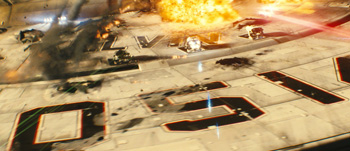 The USS Kelvin takes a hit in the film's opening action/adventure sequence. Bonding Hero to Audience: In the first five minutes of a script, screenwriters bond the audience with the hero using comedy, coolness or crisis. The key is to have the audience experience the unique moment with the hero. 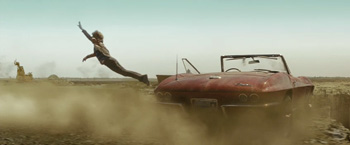 Young Kirk leaps from his joyride before it drops over the cliff. Statement of Theme: The film’s theme is revealed in the first five minutes. Typically, a character poses a thought-provoking question to the hero. Many screenwriters use this moment to introduce the Central Question that drives the Action Plot. In Star Trek, Kirk and Spock share the role of the protagonist. Spock drives the theme and Kirk the action plot. Spock’s father introduces the theme with young Spock, “You are capable of determining your own destiny, the question is, which path will you choose?” 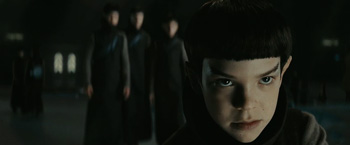 Schoolmates attempt to provoke Spock to display human emotions The Catalyst: Around pages 10 – 12, the story is put into motion and sends the audience into the adventure. This can be accomplished with a letter or mysterious package arriving, someone dieing, or the arrival of unique news with a deadline attached. In Star Trek, Captain Pike challenges Kirk, "Your father was captain of a starship for 12 minutes...": '....he saved 800 lives. Including yours. I dare you to do better. Enlist in Starfleet.” 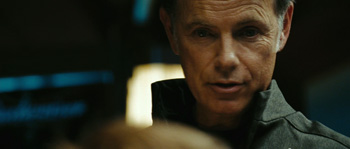
Captain Pike challenges Kirk to be a captain. Gulp, Here Goes: Between pages 12 – 24 the hero debates the “Should I, or Shouldn’t I?” by verbalizing his thoughts. Then he gulps hard and takes action. 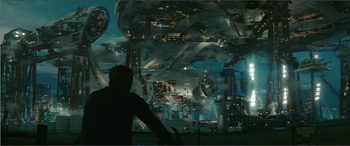
Kirk considers the challenge to join Starfleet. Turning Point 1: This distinct scene introduces a turn of events that forces the hero out of the thesis world and into an upside down version or its antithesis. It sends the hero in a new direction, which eventually gives him the skills needed to succeed back in the thesis world and resolve the story. The scene takes place around pages 17 – 21. 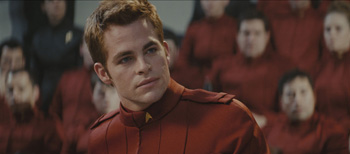 Kirk is suspended from Starfleet duty until his hearing concludes. Intro Sub-Plot B: By page 30, the audience needs a little break from the Action Plotline, an ideal time to introduce an underlying internal heart based story. It’s also the time to introduce new characters that live in the upside down world the story just turned into. The strongest characters would be the antithesis of key characters we’ve met in Act 1. 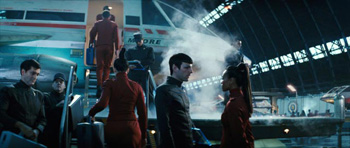 The love interest is revealed as the team boards the shuttle to Enterprise. One Sheet Pay-off: During pages 30 – 55, the screenwriter delivers the goods that the audience expected from seeing the One Sheet (movie poster) or trailer. These scenes are where the hero learns what he needs for Act 3, embraces it and eventually lives it. The hero’s education is typically done in a fun and games style. |
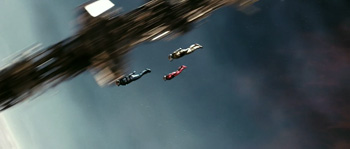 Kirk, Sulu and an ensign do a free fall to save the planet Vulcan from destruction. Raising the Stakes: Page 55 is the top of the story’s arc. This scene typically gives the hero a false hope, where he seems to get everything he thinks he wants – Life can’t get much better and he has a lot to lose in the coming pages. The fun cool things end and the pace picks up as the story races toward the finale. It sets up Turning Point 2, which is the antithesis of this scene. 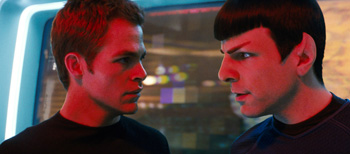 Circumstances put the future friendship of Kirk and Spock at risk. Empower the Antagonist: During pages 55 – 75 the hero’s hope is dashed as the bad guys move in and their evil increases. This is where chase scenes occur, bad guys regroup and the antagonist focuses efforts on destroying the hero. It is the antithesis of the One Sheet Pay-Off scenes. The larger the evil one becomes, the more powerful the climax. 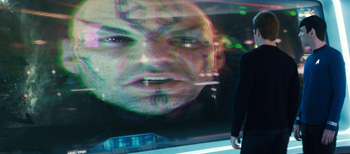 Nero corners the Enterprise and makes demands of its crew. Lost Hope: By page 75 the hero has lost hope. The bad guys have the upper hand and the hero sits in self-pity. This moment is the antithesis of Raising the Stakes on page 55. 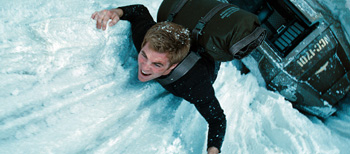 After being marooned, Kirk loses hope. The Inner Battle: The hero explores his feelings of lost hope or the darkness within his own soul during the next 3-5 minutes (pages 80 – 85). He questions why everyone has forsaken him. 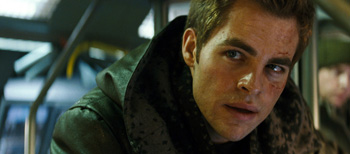 Kirk decides to risk his life for the crew of Enterprise. Turning Point 2: This Turning Point is launched when the light bulb goes on and the hero realizes how to solve the problems in the Action Plot and Sub-Plot B. It merges the external story with the internal heart based story and creates a solution for the hero to apply.  Kirk takes the captain’s seat and its responsibilities. Battle for Success: Pages 85 – 105 bring resolution to the Action Plot and Sub-Plot B. The hero uses the lessons learned in Act 2 to get rid of the bad guys, turn over the old world ‘s way of thinking in Act 1 and launch the new world’s way of thinking in an emotionally satisfying way with a clear directive and future. 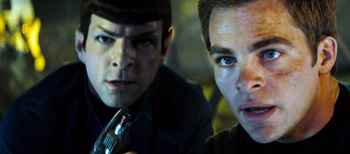 Kirk and Spock team to battle Nero and his crew. Climax: Around page 105 the audience is given the ultimate emotional moment as the hero claims victory. If it doesn’t feel climatic, the story wasn’t properly set up in Act 1 or the story died in Act 2. If the emotions aren’t significantly raised, the bad guys weren’t empowered enough in Act 2.  No spoiler information here. Closing Imagery: The epilogue happens between pages 105 – 110 and proves that the new world’s ways of thinking are real, accepted and beneficial to all. It is the antithesis of the Opening Imagery. 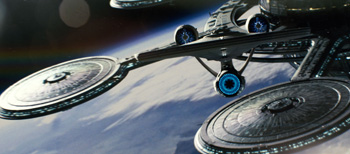 Thanks to Enterprise, the United Federation of Planets maintains the good life for its people. Caution should be exercised in following this beat sheet, as many stories tend to create its own beats and pacing. Finding the story’s internal pulse will help the screenwriter stay focused on the message and emotional appeal. Additional beats will be added if the story requires a Sub-Plot C, D, or E. Original article content of this
site is Copyright © |








